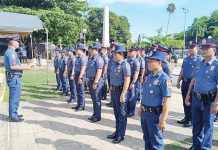[av_one_full first min_height=” vertical_alignment=” space=” custom_margin=” margin=’0px’ padding=’0px’ border=” border_color=” radius=’0px’ background_color=” src=” background_position=’top left’ background_repeat=’no-repeat’ animation=”]
[av_heading heading=’10 Dinagyang tribes seek festival glory’ tag=’h3′ style=’blockquote modern-quote’ size=” subheading_active=’subheading_below’ subheading_size=’15’ padding=’10’ color=” custom_font=”]
BY GLENDA SOLOGASTOA
[/av_heading]
[av_textblock size=” font_color=’custom’ color=’#0a0a0a’]
Sunday, January 22, 2017
[/av_textblock]
[av_textblock size=” font_color=’custom’ color=’#0a0a0a’]
ILOILO City – See, feel and fall in love with Dinagyang. That’s the goal of 10 contingents performing in the festival’s ati-ati tribes competition today.
Will Tribu Salognon of Jaro National High School successfully defend its 2016 championship crown?
Will Tribu Panayanon, the 2015 champion dethroned last year, make a successful comeback?
This year’s festival tagline “See…Feel…Love” encapsulates the invitation to experience Iloilo through the city’s premier festival. It may not be as ancient as the Ati-Atihan of Kalibo, Aklan but it is known more for the participants’ impressive choreography and striking costumes that reflect the ingenuity, craftsmanship and artistry of the Ilonggos.
Aside from Salognon and Panayanon, the eight other contesting tribes today are Paghidaet, Obreros, Ilonganon, Abiador, Dagatnon, Buntatalanit, Pan-ay, and Amihan.
They will be performing in five judging areas after a 6 a.m. Mass at the San Jose Church in Plaza Libertad.
The judging areas are the Freedom Grandstand, Iloilo provincial capitol, Quezon-Ledesma streets, Mabini Street, and Maria Clara.
Just like yesterday’s Kasadyahan contest, the performance of today’s ati-ati tribes will be carousel – competing contingents will be simultaneously performing in the judging areas.
THE TRIBES
Salognon – This last year’s champion beat perennial festival champion Tribu Panayanon of Iloilo City National High School.
The term “Salognon” came from the word “Salog”, the old name of Jaro.
“Salognon” refers to anyone or anything from Salog. In 2005, the tribe took on the name “Ang Taga-Jaro.”
Paghidaet – This tribe of La Paz National High School first joined in the competition in 1999. It took the name “Paghidaet” because Lapazenians were devoted to the Santo Niño and Our Lady of Peace and Good Voyage, the patroness of La Paz district.
In its 12 years of joining the competition, the tribe was five-time champion.
Obreros – This is the first truly community-based tribe. Bo. Obrero National High School, barangay officials and constituents of Bo. Obrero joined hands to form it.
Ilonganon – The pride of Jalandoni Memorial National High School, its name refer to the natives of Iloilo. It became a champion twice – in 2006 and in 2007.
Abiador – This is a new tribe formed by the Asian College of Aeronautics (ACA) last Oct. 5, 2016. “Abiador” is Spanish for “aviator” or “mechanic.” Students of ACA want to prove they are not only good in the field of aviation but also in cultural endeavors.
Dagatnon – Representing Ramon Avanceña National High School this tribe started participating in 1998 as Tribu Sigabong, evoking the sound of firecrackers and pyrotechnics which Arevalo district is famous for.
Panayanon – Formely Tribu Silak and Tribu Lunok, it is the pride of Iloilo City National High School. Its name aims to showcase the diverse cultural heritage of the entire Panay.
It was the Dinagyang 2015 festival grand slam champion. It was also the Aliwan Fiesta 2013 grand champion and chosen by the Philippine Tourism Board of the Department of Tourism to represent the country for their promotion “It’s More Fun in the Philippines” in New York City and in Los Angeles, California during the 115th Philippine Independence Day Parade.
Buntatalanit – It is a new tribe in the Dinagyang Festival landscape and community-based. Tiu Cho Teg-Ana Ros Foundation Integrated School collaborated with the constituents of barangays Buntatala and Lanit in Jaro district.
Pan-ay – This tribe of Fort San Pedro National High School started joining the Dinagyang Festival in 2006 but took a hiatus from 2008 to 2010.
In 2011, new principal Dr. Blesilda Floro revived the tribe and became the champion.
It also landed a first place finish in the Grand National Dance Festival, Aliwan Fiesta in Manila.
In 2012, it retained its overall standing as champion.
The tribe performed in the international scene on the 68th Liberation Day of Guam, USA.
Amihan – This tribe is from Mandurriao National High School. Before joining in 2011, it successfully conquered the Kasadyahan competition using the names Tribu Babaylan, Tribu Kalinaw, Tribu Mandurriaonon and Tribu Madyaas. It bagged the championship trophy in the Kasadyahan 2000 under the name Tribu Igorot.
“Amihan” means cool northeast wind.
MERRYMAKING
Dinagyang is the Hiligaynon word for revelry or merrymaking. The festival started in 1967 when a replica of the image of the Sto. Niño (Child Jesus) was brought from Cebu to the San Jose Parish.
According to Mayor Jed Patrick Mabilog, Dinagyang is the leading tourism, cultural, religious and socio-economic promotional vehicle and symbol of Iloilo City.
“It reflects city’s continuing progress and sustainable development,” said Mabilog.
Ilonggos, however, should not forget the “essence of the festival,” said Mabilog – faith in God and giving honor to the Child Jesus.
“While everyone is excited to celebrate 2017 Iloilo Dinagyang, we should not forget the religious aspect of the festival,” said Mabilog./PN
[/av_textblock]
[/av_one_full]



